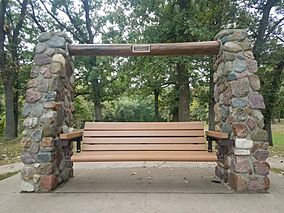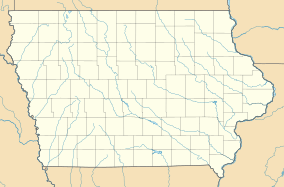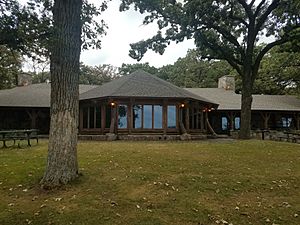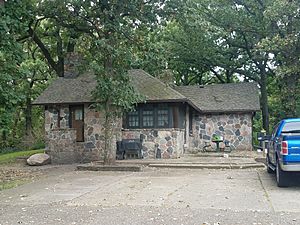Gull Point State Park facts for kids
Quick facts for kids Gull Point State Park |
|
|---|---|

Sheryl Christensen-Martyr swing
|
|
| Location | Dickinson, Iowa, United States |
| Area | 380 acres (150 ha) |
| Elevation | 1,411 ft (430 m) |
| Established | 1933 |
| Governing body | Iowa Department of Natural Resources |
| Website | Gull Point State Park |
|
Gull Point State Park, Area A
|
|
| Built | 1934-1935 |
| Built by | Civilian Conservation Corps |
| Architect | Central Design Office, Ames |
| Architectural style | Rustic |
| MPS | CCC Properties in Iowa State Parks MPS |
| NRHP reference No. | 90001661 |
|
Gull Point State Park, Area B
|
|
| Built | 1934-1935 |
| Built by | Civilian Conservation Corps |
| Architect | Central Design Office, Ames |
| Architectural style | Rustic |
| MPS | CCC Properties in Iowa State Parks MPS |
| NRHP reference No. | 90001662 |
| Added to NRHP | November 15, 1990 |
Gull Point State Park is a cool state park in Iowa, United States. It's found on West Okoboji Lake in the town of Wahpeton. This park is the main state park in the fun Iowa Great Lakes area. Two parts of the park are even listed as important historic places because of their special history.
Park History and Buildings
From 1934 to 1935, a group called the Civilian Conservation Corps (CCC) Company 778 worked at Gull Point. The CCC was a program during the Great Depression that helped young men find jobs. They built many things in parks across the country. The buildings they made at Gull Point were designed to look like they belonged in nature. They used local materials and a style called "rustic architecture."
There are two main areas in the park that are listed as historic. "Area A" includes the park's lodge and boathouse. The CCC started building the lodge in July 1934 and finished it in April 1935. It's a uniquely shaped building made from rough sandstone rocks. It has a cool roof with different sections. The boathouse was built between September 1934 and February 1935. It's a rectangular building with a six-sided tower. The boathouse could hold 30 boats and had an office for the park's manager.
"Area B" includes the custodian's residence (where the park manager lived), a service building, and the west entrance gates. The residence was built from September 1934 to May 1935. It's an L-shaped house made of stone, with two bedrooms, a bathroom, a living room, a dining room, and a kitchen. The service building, finished in March 1935, is a single-story building. It has a two-car garage and an office. The west entrance gates were a bit harder to build because they needed special stone. They have four tall pillars made of split sandstone boulders.
In 1974, the Iowa Conservation Commission bought some land near the park. This land used to be a golf course and was later owned by the Boy Scouts. A man named Barney Peterson worked hard to protect this land. To honor him, a special path was named the Barney Peterson Nature Trail. This trail is about 1.5 miles long and goes past old structures, like a chapel the Boy Scouts used and an old golf tee box.
Park Facilities
Gull Point State Park has some great places for visitors.
- The park's lodge is the biggest one built by the CCC in Iowa during the 1930s. It can hold up to 140 people and can be rented for parties or events.
- There are also several picnic shelters where you can enjoy a meal outdoors.
- The campground is very popular and has 112 spots for tents or RVs. More than half of these spots have electricity.
- The campground also has modern restrooms, showers, and a playground for kids.
Fun Activities
Gull Point State Park offers many ways to have fun, especially on the water!
- You can swim at the beach or launch your boat from the boat ramp.
- It's also a great spot for fishing.
- On the western side of the park, you'll find nature trails perfect for exploring.
- In the winter, these trails are great for cross-country skiing.
Park Geology
Gull Point State Park is located on a piece of land that sticks out into West Okoboji Lake. This lake is the deepest natural lake in Iowa! The area around the lake has a unique landscape with lakes, wet areas, and bumpy hills. This special landscape was formed by huge sheets of ice called glaciers.
These glaciers moved across the land and then melted away between 13,500 and 12,000 years ago. As they melted, they left behind piles of rock and dirt, forming the hills. Big blocks of ice also got stuck in the ground and, when they melted, created many of the lakes and wetlands you see today. If you walk along the shores of Gull Point, you'll see many large rocks called glacial erratics. These are rocks that the glaciers carried all the way from far north and then dropped here!




